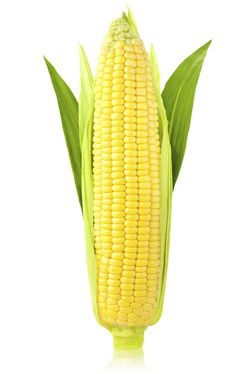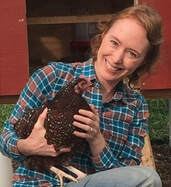
In fact, I have in mind a more general list of the 3 top foods we consume in modern America. In fact, these foods make up a shocking 67% of the modern Western diet (based on calorie intake)! This is a huge change from the way our ancestors ate, when, on average, primitive man consumed over 3,000 different foods on a regular basis, and over the course of history, humankind has eaten approximately 80,000 different species of plants, animals, and edible fungi. With these numbers in mind, the fact that we now get 2/3 of our calories from just 3 foods should give us pause.
It should also make us wonder if this unprecedented lack of variety in our diet might not have a causal link to today's increased incidence of many modern diseases...
It's time to bring diversity back to our diet. But first, if you're ready to find out which 3 foods you're eating more of than anyone has ever before in human history, read on.
If you guessed corn, soy, and wheat - congratulations!
If you're saying, "huh?? I don't eat that much of those things," well, think again. If you add up all of the modern foods made from, cooked in, or raised on these 3 foods, indeed, 67% may actually start to seem a bit low....
Here are just a few of the most common food ingredients you probably eat every single day, which are made from these 3 foods:
- high fructose corn syrup (HFCS)
- corn oil
- soybean oil
- soy protein
- refined wheat flour
- hundreds of other food additives such as maltodextrin, corn or wheat starch, soy lecithin, modified vegetable protein, mono and diglycerides, etc.
Fried foods are typically fried in either soybean or corn oil, so if you eat fried food or fast food, you're adding to the tally. These oils can also be found in potato chips, candies, store-bought tomato sauce, corn chips, salad dressings, breaded meats, and more.
When it comes to wheat, that's everywhere as well - in your breakfast cereal or muffin, your pasta lunch plate, and your dinner roll.
But that's not all. We are also feeding the majority of our food animals on cheap corn and soy, meaning that even the meat we eat is corn-based!
Factory farmed cows and chickens are fed mostly corn (instead of their natural diet of forage and grass), which encourages the growth of unhealthy bacteria (such as E. coli) in their digestive tracts, alters the omega-3 to omega-6 balance of fats, and diminishes their content of healthy fats. (See my recent article on grass-fed beef for more of the problems inherent to factory-farmed meats.)
In fact, now we're even feeding our farmed fish on corn and soy! Even if you don't believe the fact that ruminant animals were never meant to eat large amounts of grain, there can be no doubt that grain is a highly unnatural form of food for a fish!
When it comes down to it, whether you're eating chicken, beef, pork, or fish, you are essentially feeding your body corn and soy - at least from a biochemical standpoint.
Okay, so by now you may be saying, so what? What's the big deal about eating so much of these grains anyway?
Well, we could write a whole book on that! (But we won't - I'm keeping it short(ish) for today.) :-)
But here are just a few reasons why this type of unbalanced diet is highly unhealthy:
- Eating corn and soy oil, as well as corn and soy-fed animal meats, skews the ratio of omega-6 to omega-3 fats in our diet from the healthy ratio of approximately 1:1 to as high as 30:1! This massive imbalance has been found to be one of the leading causes of inflammation in the body. As you may know, inflammation is a leading cause of most modern diseases, including cancer, heart disease, and obesity.
- The great amounts of wheat we're consuming have led to increasing problems with gluten intolerance over the past few decades, with some people now unable to even tolerate small amounts of these proteins without illness.
- Eating high levels of grains and HFCS causes dramatic blood-sugar swings (leading to hormone imbalances, cravings, predidabetes, and weight gain), and reduced insulin sensitivity, along with development of Type 2 diabetes.
- Soy and corn are the two crops which are the most highly genetically modified (so far, although many more crops are following suit). Not only does this mean more pesticides and herbicides are able to be used on these foods, but there is some evidence that compounds in GM soy may act as xenoestrogens, leading to hormone disruption in both men and women, as well as related weight gain.
Given that our massively high intake of these 3 foods is a relatively new phenomenon, originating only over the past century, when corn, soy, and wheat became multi-billion dollar industries with the abundance of cheap fossil fuels, it's no wonder that the problems listed above can all be qualified as "modern" health concerns.
It's also no wonder that food sensitivities, intolerances, and allergies have skyrocketed - even just within my lifetime! The fact is, the human digestive system is not well-equipped to handle such massive quantities of these 3 foods (or any other 3 single foods for that matter). As I mentioned above, diversity is key to a healthy human diet.
So, how the heck can you avoid eating so much of them, since it seems they're just about everywhere??! Do you really have to STOP eating them completely? If not, what is a reasonable, healthy amount of corn, soy, and wheat for the average person to consume?
Based on thousands of years of human history, and the wide diversity of foods we have consumed throughout our existence on this planet, you could safely estimate that up to 4% of your diet (total caloric intake) could consist of these 3 foods.
Obviously this would entail a truly stupendous change in our eating habits in general. But you can start today, with just a few simple changes.
Here are 4 simple tips for cutting out a huge portion of that 67%, starting now:
1. Learn to cook.
To start with, if you don't already cook most of your own meals, it's no wonder you're eating so much of these 3 foods! Cooking for yourself is one of the best things you can do for your health, and the health of your family. It allows you to eat a much greater variety of foods than what you find in a fast food joint. If you've never cooked before, it can seem daunting, but start off small, and try simple recipes using fresh ingredients you enjoy. Before you know it, you'll be filling your kitchen with good smells, and your body with good, healthy foods that didn't come from a drive-through window! (Check out our Cooking From Scratch page for some helpful tips and tools.) What should you cook? Check out the next 2 tips and get ready to go shopping...
2. Avoid processed foods.
That's right - you knew I was going to say it, didn't you? If you have trouble avoiding temptation, simply shop the perimeter of the grocery store - buy only fresh produce, meat, and fish, and then make a beeline for the door! Avoid the inner aisles as much as possible, as this is where the processed foods are lurking. When visiting the inner aisles for things like beans or canned goods, make a list to guide you, and stick to it. Buy fresh foods you enjoy, and try new ones you haven't tried before as well. You can experiment with fun new ways to cook them, now that you're cooking for yourself - you're no longer limited by the menu at your favorite diner or restaurant!
3. Buy grass-fed meat.
Not only are you getting a healthier product (that wasn't fed on corn and soy), you're also supporting animal health and well-being, and those who practice responsible animal husbandry. If you buy fish, stick to wild-caught, and sustainably fished. (Check out http://seafood.edf.org/ for a sustainable seafood guide.)
4. Give up soda pop. (Just do it!)
Yes, I know it might be difficult - Coke actually is addictive! But soda is one of the absolute worst things you can put into your body. It really has no redeeming nutritive qualities. NONE. And that goes for the "diet" kind too. Just give it up already! You don't have to go cold-turkey - just start cutting down your intake gradually. Replace your daily lunchtime soda with a glass of water instead. If you need some flavor, add mint springs, cucumber slices, or a squeeze of citrus juice. Or combine all 3 of these in a large bottle of water for a surprisingly refreshing and delicious beverage. Your body, your health, and your waistline will all thank you!
To your health,
Rose.
P.S. Thanks to nutrition specialist and author Mike Geary for some of the statistics and info used in this article.



 RSS Feed
RSS Feed